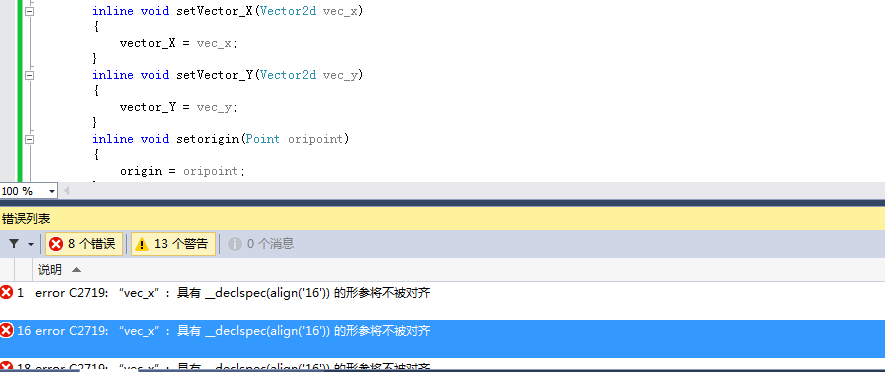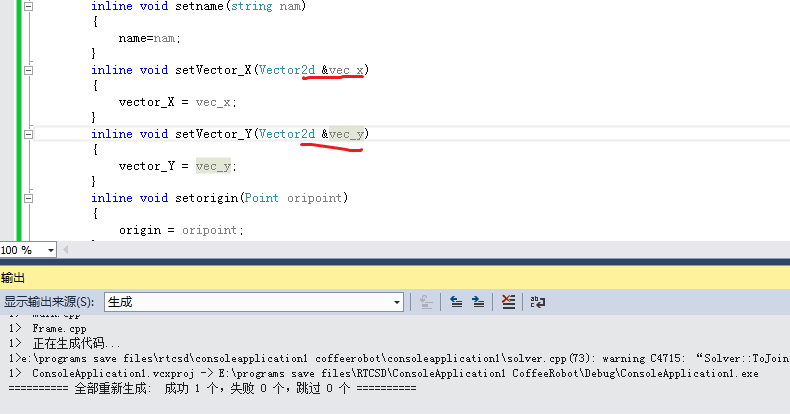一.错误如下

具体问题及解决办法描述如下(引自http://www.fx114.net/qa-278-97757.aspx):
英文提示:error C2719: 'p': formal parameter with __declspec(align('16')) won't be aligned
中文提示:error C2719: “p”: 具有 __declspec(align('16')) 的形参将不被对齐导致整个现象的主要原因是使用了Eigen库,Eigen为了使用SSE加速,所以内存分配上使用了128位的指针。
更加准确的说法:
“First, "fixed-size" should be clear: an Eigen object has fixed size if its number of rows and its number of columns are fixed at compile-time. So for example Matrix3f has fixed size, but MatrixXf doesn't (the opposite of fixed-size is dynamic-size).
The array of coefficients of a fixed-size Eigen object is a plain "static array", it is not dynamically allocated. For example, the data behind a Matrix4f is just a "float array[16]".
Fixed-size objects are typically very small, which means that we want to handle them with zero runtime overhead -- both in terms of memory usage and of speed.
Now, vectorization (both SSE and AltiVec) works with 128-bit packets. Moreover, for performance reasons, these packets need to be have 128-bit alignment.
So it turns out that the only way that fixed-size Eigen objects can be vectorized, is if their size is a multiple of 128 bits, or 16 bytes. Eigen will then request 16-byte alignment for these objects, and henceforth rely on these objects being aligned so no runtime check for alignment is performed.”
二.解决方案
分为四种情况:
Cause 1: Structures having Eigen objects as members
Cause 2: STL Containers
Cause 3: Passing Eigen objects by value
Cause 4: Compiler making a wrong assumption on stack alignment (for instance GCC on Windows)
每种情况可以对照官方的说法。可以参考如下链接
http://eigen.tuxfamily.org/dox/TopicUnalignedArrayAssert.html
在此不再重复表述。
三.我的解决方法
eigen 3.1.2有 bug, 重装Eigen;
关闭使用 预编译头;
关闭编译选项里面的16位对齐;
把Eigen::Vector4f 传值改为 传引用 Eigen::Vector4f &;
把结构体 传值 全部转换为 传引用。躲过对齐!!!
编译器选项:C/C++ ---代码生成---结构图成员对齐;
四.对stl vector 进行修改
参照:http://blog.csdn.net/pkueecser/article/details/8602656
产生问题的resize()方法,改为:
void resize(size_type _Newsize, const _Ty & _Val)
{ // determine new length, padding with _Val elements as needed
if (size() < _Newsize)
_Insert_n(end(), _Newsize - size(), _Val);
else if (_Newsize < size())
erase(begin() + _Newsize, end());
}
注意其中红色部分,将传值改为传参,避免在参数栈上创建被对齐的结构的对象。然后,在我们使用std::vector< Foo<5, float> >之前包含我们的foo_vector.hpp头文件,就可以正常使用了。 注意红色部分.....
本人参照第三点 把结构体 传值 全部转换为 传引用。躲过对齐!!! 结果如下:
